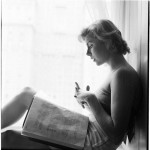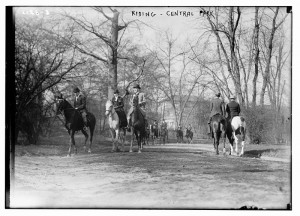Re-reading Truman Capote’s Breakfast at Tiffany’s
 Afraid my Kindle might run out of juice, I wanted a small book for backup for a recent flight and, because I wanted something light to carry, grabbed off my bookshelves the novella Breakfast at Tiffany’s. I’d read it at least three times over the years and thought I might be bored. Think again. Capote amazed me.
Afraid my Kindle might run out of juice, I wanted a small book for backup for a recent flight and, because I wanted something light to carry, grabbed off my bookshelves the novella Breakfast at Tiffany’s. I’d read it at least three times over the years and thought I might be bored. Think again. Capote amazed me.
Consider his introduction of the character Mag Wildwood, who will become a short-term roommate of heroine Holiday Golightly:
‘…She was a triumph over ugliness, so often more beguiling than real beauty, if only because it contains paradox. In this case, as opposed to the scrupulous method of plain good taste and scientific method, the trick had been worked by exaggerating defects: she’d made them ornamental by admitting them boldly. Heels that emphasized her height, so steep her ankles trembled; a flat tight bodice that indicated she could go to a beach in bathing trunks; hair that was pulled straight back, accentuating the sparseness, the starvation of her fashion model face. Even the stutter, certainly genuine but still a bit laid on, had been turned to advantage. It was the master trick, that stutter; for it contrived to make her banalities sound somehow original, and secondly, despite her tallness, her assurance, it served to inspire in male listeners a protective feeling. To illustrate: Berman had to be pounded on the back because she said, “Who can tell me w-w-where is the j-j-john?”; then, completing the cycle, he offered an arm to guide her himself.’
The photo above, which brings to my mind Holiday Golightly sitting in the window of her apartment or of the apartment of her neighbor, the narrator, down one flight on the fire escape, is actually Stanley Kubrick’s 1949 photograph of Betsy Von Furstenberg, reblogged here from http://twistedsifter.com/2011/12/stanley-kubricks-new-york-photos-1940s/
Breakfast at Tiffany’s was set during World War II.
 On a pivotal day in the plot, Holly and the narrator, whom she calls “Fred” after her brother, go horseback riding in Central Park. The narrator says that the stable is gone by the time he’s telling the story. The picture below, undated from Library of Congress archives, obviously pre-dates WWII, but I offer it in the spirit of the book. Click on the picture to enlarge it for a better view.
On a pivotal day in the plot, Holly and the narrator, whom she calls “Fred” after her brother, go horseback riding in Central Park. The narrator says that the stable is gone by the time he’s telling the story. The picture below, undated from Library of Congress archives, obviously pre-dates WWII, but I offer it in the spirit of the book. Click on the picture to enlarge it for a better view.
If you’ve never read Breakfast at Tiffany’s–and I’m guessing many people under forty haven’t–by all means do.
Gary Garth McCann
First-prize winner for short works and for suspense/mystery, Maryland Writers’ Association, Gary Garth McCann is the author of the novella Young and in Love? and of the novels The Shape of the Earth and The Man Who Asked To Be Killed, praised at the Washington Independent Review of Books. His most recent published stories are available online in Chelsea Station Magazine, Erotic Review Magazine, and in Mobius: The Journal of Social Change. His other stories appear in The Q Review, reprinted in Off the Rocks, in Best Gay Love Stories 2005, and in the Harrington Gay Men’s Fiction Quarterly. See his blogs at garygarthmccann.com and streamlinermemories.com.
- Web |
- More Posts(57)